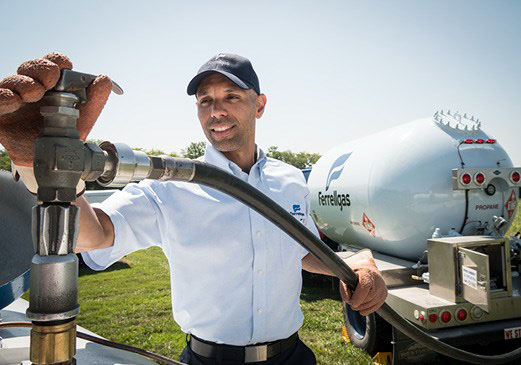How much pressure is in a propane tank?
For the end-user, propane is a safe, easy to use heating source that can power barbecue grills, home heating systems, and even refrigerators. But along the way, from extraction in the field to storage at your local Ferrellgas office, propane undergoes a number of different processes to ready it for commercial and residential use.
Why is propane under pressure?
The key to propane’s portability, and what packs so much energy into a relatively small volume of space, is pressure. In its natural state, propane is a vaporous gas. Under pressure, however, that vapor is converted to a form that is easier to transport and store. Liquified Petroleum Gas, or LPG, is the result of pressurizing propane gas, which causes it to drop below its boiling point of -44 degrees Fahrenheit.
At this temperature or below, propane remains in a liquid state, which condenses a large amount of energy into a small volume of fluid. When the propane’s temperature increases, it begins to “boil” off and this vapor is the usable form of propane that is converted to flame and heat your appliances. In this state, propane gas has a natural reaction to expand until it reaches equilibrium, or where it has normalized with atmospheric pressure.
Is there a range my propane tank’s pressure should be within?
There are four “Gas Laws” that explain the relationship between gases, pressure, temperature, and volume. Generally, propane pressure should be between 100 and 200 psi to ensure that the liquid propane gas remains in a liquid state.
| > 100 psi | Low |
| 100 - 200 psi | Normal Range |
| < 200 psi | High |
Normally, the pressure inside a propane tank fluctuates slightly based on the outside temperature. For example, a standard 20-pound propane tank at 70 degrees will have 145 psi internal pressure. That same tank on a 100-degree day will have 172 psi of pressure.
Propane pressure levels exceeding 200 psi are likely to trigger a release from the safety relief valve commonly installed on propane storage tanks. This device allows propane gas to safely vent out of the tank if there’s excessive pressure.
Safety Considerations
Excessive heat
If a propane tank is in contact with extreme heat, such as a garage fire, the external heat can cause the temperature inside the tank to increase, creating a BLEVE –or boiling liquid expanding vapor explosion. As the heat raises the temperature of the propane, the vapor expands and increases the pressure inside the tank, which can lead to a rupture.
Cold temperatures
On the other extreme, propane itself is unlikely to freeze –that would require a temperature below -306 degrees Fahrenheit. However, trace amounts of water in supply lines can freeze inside fuel ports and fittings in extremely cold conditions.
How to check the pressure in your propane tank
To check the pressure on your tank:
- Use a pressure gauge. This device can be installed between the shutoff valve and the initial regulator and is particularly common on larger residential systems.
- Release full tank pressure to the gauge, allowing enough gas to pass through to lower the pressure gauge reading by 10 psi.
- Close the shut-off valve and allow the system to stand for three minutes without showing an increase or decrease in pressure. Any increase in pressure indicates a faulty valve, while a decrease indicates a leak.

Safety tips for maintaining your tank’s pressure
1. Be cautious of direct sunlight.
On smaller systems, such as propane barbecue grills, it’s important to remember that exposure to direct sunlight can increase both the temperature and pressure inside your propane tank.
2. Keep an eye on dark-colored tanks.
If your tank is painted black or another dark, heat-absorbing color, it could further increase the internal temperature and pressure of the tank.
3. Store your tank in a shaded, well-ventilated area.
The best practice is to store your grill and tank in a shaded and well-ventilated area. While your tank will be equipped with a pressure relief valve – also known as a “pop-off valve” – in case the pressure rises too high, there’s no need to tempt fate –or waste the propane you’ve purchased.
4. Avoid damaged and rusted tanks.
It’s important to make sure your tank is not damaged and is free from rust, which could likewise affect not only the tank’s performance, but its ability to maintain the proper pressure.
Tank painting & rust removal by Ferrellgas
Ferrellgas locations offer tank painting and rust removal services, and qualified technicians can inspect your tank to ensure it’s in good working order. Ferrellgas also produces resources with valuable information about propane tank safety, and additional information that will help you get the most from your tank.
Knowing how much pressure is in a propane tank is important, but it’s only part of the information you need to know to get the most from your experience with propane.
Contact a Ferrellgas location near you
Understanding how your tank – and propane gas – reacts to extreme temperatures, the safety devices available, and the importance of safety and maintenance, will help ensure you get the most from each tank of propane you use. And don’t forget that there’s a Ferrellgas location near you with experts who are ready to help you answer any question.
CATEGORIES
Archives
- Summer 2025
- Spring 2025
- Winter 2024
- Fall 2024
- Summer 2024
- Spring 2024
- Winter 2023
- Fall 2023
- Summer 2023
- Spring 2023
- Winter 2022
- Fall 2022
- Summer 2022
- Spring 2022
- Winter 2021
- Fall 2021
- Summer 2021
- Spring 2021
- Winter 2020
- Fall 2020
- Summer 2020
- Spring 2020
- Winter 2019
- Fall 2019
- Summer 2019
- Spring 2019
- Winter 2018
- Fall 2018
- Summer 2018
- Spring 2018
- Winter 2017
